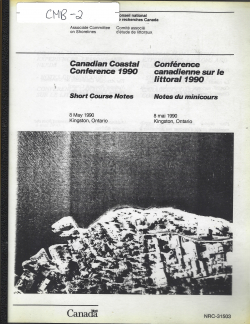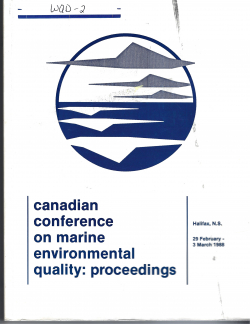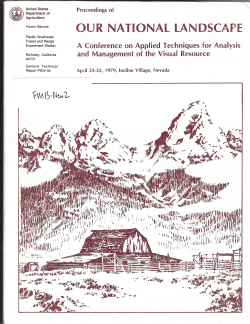Canadian Coastal Conference 1980 - Proceedings / Comptes-Rendus Conference Canadienne Sur Le Littoral De 1980

Type
Publication
Authors
LSmith ( Leigh Smith )
Category
SCIWC Library
[ Browse Items ]
Publication Year
1980
Pages
13
Subject
Shore Erosion due to tides around St. Andrews New Brunswick
Tags
Abstract
"The eastern shore of the St. Andrews peninsula has been formed by partial erosion of several drumlins and by differential transport of the resulting sediments. As the drumlins were formed at various elevations and have different marine exposure the style of shore erosion and the resulting beach forms are unique to each.
The last glacier flowed across the bedrock St. Andrews ridge at a slight angle to its long axis. The resultant perturbations formed a series of boulder-till drumlins. Isostatic rebound created the present mean sealevel and flooded these drumlins to different levels. They formed islands and an irregular east coast on the peninsula in Passamaquoddy Bay; notable for its large tidal range.
Coastal erosion, mainly by storm waves during high tide, continues to cut banks or low cliffs into these drumlins and results in rotational slumping of the boulder-clay tills. From the higher, exposed drumlins the boulders, gravels and coarsest sands are transported alongshore, to form beaches and recurved and straight spits. Due to the large tidal currents, deltas are formed both into salt marshes or inlets, and seaward. The tidal-zone beach profiles show steep slopes and both con-cave and convex profiles.
The more exposed drumlin islands shed their finer and medium-sized sediments seaward during storms, leaving residual piles of coarse gravel and large boulders which now form shoals covered at low tide.
The town of St. Andrews was originally sited along the Western shore of the peninsula, on bedrock scraped clean by the glacier. Growth of the town is now approaching the eastern shore and the siting of lots and buildings along that shore will need to take account of its coastal instability, in order to avoid the call for coastal defense measures which would be both expensive and marginally effective."
The last glacier flowed across the bedrock St. Andrews ridge at a slight angle to its long axis. The resultant perturbations formed a series of boulder-till drumlins. Isostatic rebound created the present mean sealevel and flooded these drumlins to different levels. They formed islands and an irregular east coast on the peninsula in Passamaquoddy Bay; notable for its large tidal range.
Coastal erosion, mainly by storm waves during high tide, continues to cut banks or low cliffs into these drumlins and results in rotational slumping of the boulder-clay tills. From the higher, exposed drumlins the boulders, gravels and coarsest sands are transported alongshore, to form beaches and recurved and straight spits. Due to the large tidal currents, deltas are formed both into salt marshes or inlets, and seaward. The tidal-zone beach profiles show steep slopes and both con-cave and convex profiles.
The more exposed drumlin islands shed their finer and medium-sized sediments seaward during storms, leaving residual piles of coarse gravel and large boulders which now form shoals covered at low tide.
The town of St. Andrews was originally sited along the Western shore of the peninsula, on bedrock scraped clean by the glacier. Growth of the town is now approaching the eastern shore and the siting of lots and buildings along that shore will need to take account of its coastal instability, in order to avoid the call for coastal defense measures which would be both expensive and marginally effective."
Description
This document is a copy of a presentation / paper associated with the Canadian Coastal Conference of 1980 in Burlington, Ontario.
The paper is entitled: Shore Evolution, St. Andrews Peninsula, Southwestern New Brunswick -- By Erosion of Boulder - Clay Drumlins and Littoral and Offshore Transport Along A Coast With Large Tidal Range.
By Leigh Smith, Department of Geological Sciences, Queen's University
Topic Include:
- Glacial and Sea level History
- Drumlins and Drumlinoids
- Coastal Erosion of Glacial Deposits
- Recent Coastal Deposition
- Deposition Offshore
The paper is entitled: Shore Evolution, St. Andrews Peninsula, Southwestern New Brunswick -- By Erosion of Boulder - Clay Drumlins and Littoral and Offshore Transport Along A Coast With Large Tidal Range.
By Leigh Smith, Department of Geological Sciences, Queen's University
Topic Include:
- Glacial and Sea level History
- Drumlins and Drumlinoids
- Coastal Erosion of Glacial Deposits
- Recent Coastal Deposition
- Deposition Offshore
Number of Copies
1
| Library | Accession No | Call No | Copy No | Edition | Location | Availability |
|---|---|---|---|---|---|---|
| SCIWC Administration | 13127 | CMB-3c | 1 | Yes |




